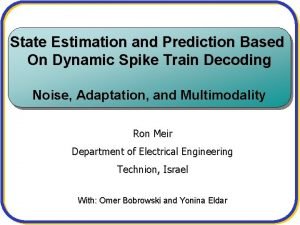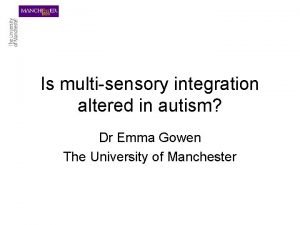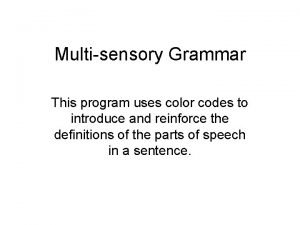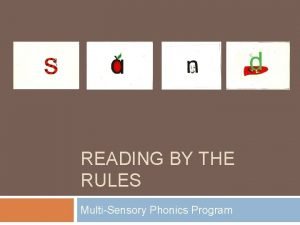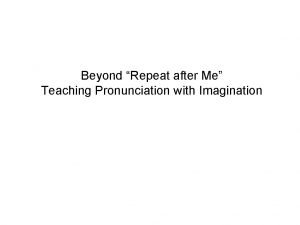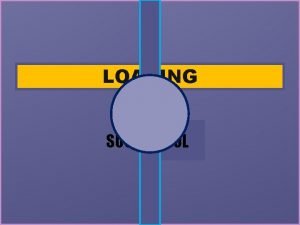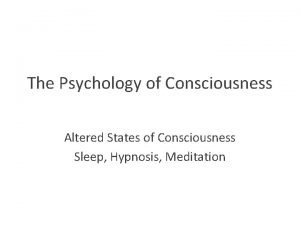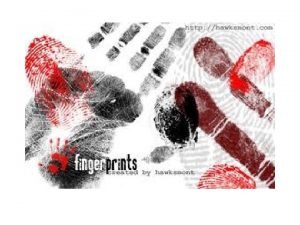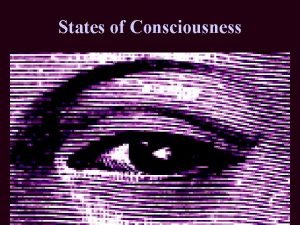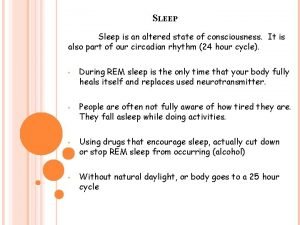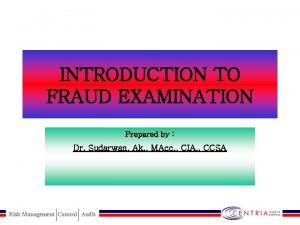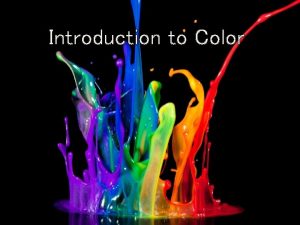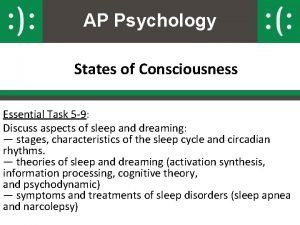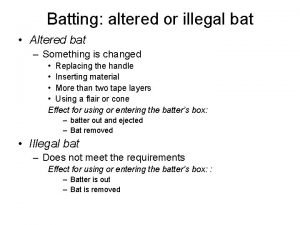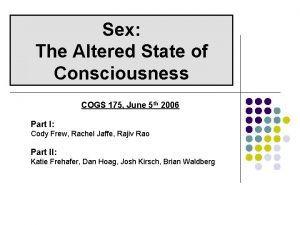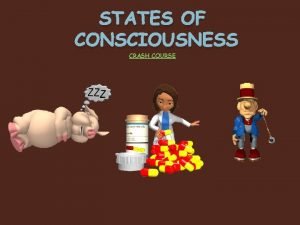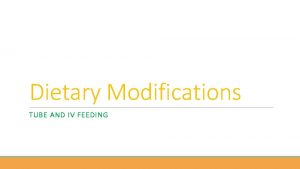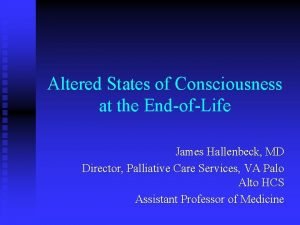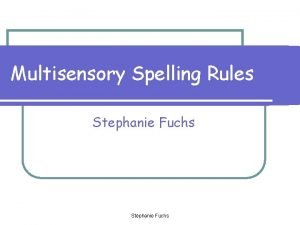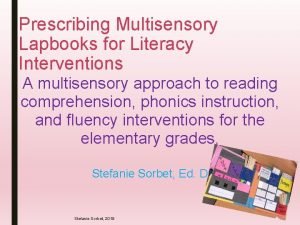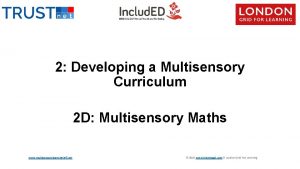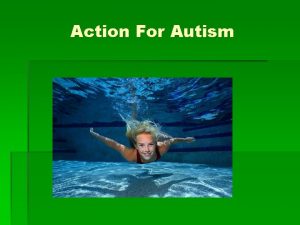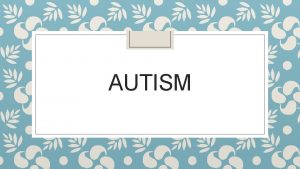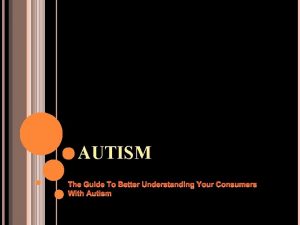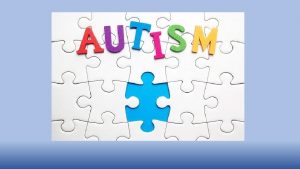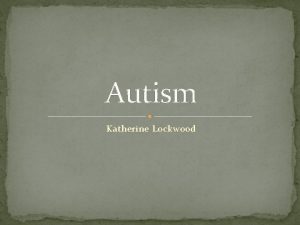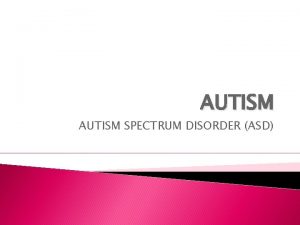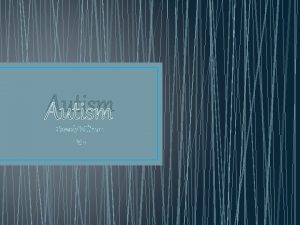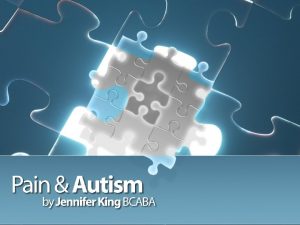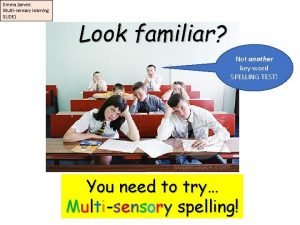Is multisensory integration altered in autism Dr Emma






























- Slides: 30

Is multi-sensory integration altered in autism? Dr Emma Gowen The University of Manchester

Today’s outline • Scientific research perspective – Experimental research • Sensory issues – Some stuff you may well already know • Multi-sensory integration – What it means • Previous multi-sensory integration studies • Multi-sensory study from Manchester

Sensory issues • Sensory issues are common in autistic people • Questionnaire studies report >70% people affected (Baranek et al. , 2006; Crane et al. , 2009; Leekham et al. , 2007) ‘The clamor of many voices, the different smells – perfume, cigars, damp wool caps or gloves – people moving about at different speeds, going in different directions, the constant noise and confusion, the constant touching were overwhelming. ’ (Grandin and Scariano, 1986, p. 129)

Sensory issues Symptom Example Hypersensitivity Unable to cope with touch, Use of ear defenders Hyposensitivity Do not respond to name Sensory overload Overwhelmed by different sensory experiences Sensory distortions Still objects perceived as moving Sensory tune-outs Vision may suddenly blank out Difficulties processing from more than one sense at once Need to experience one sense at a time Difficulties in identifying source sense of stimulation Which sense am I experiencing? Harrison and Hare, 2004

Sensory issues • Occur across all senses and multiple senses can be affected in one individual (Kern et al. , 2006; 2007; Leekham et al. , 2007) • Occur in all age groups (Crane et al. , 2009; Leekham et al. , 2007) – Potential to improve with age? (Kern et al. , 2006) • Individuals have different experiences – Experiences can vary according to senses affected and severity (Lane et al. , 2010) • Can severely affect quality of life – Stress – Modification of behaviour • Avoidance of environments/social touch • Sensory seeking – Restrictive lifestyle • We don’t know the cause and therapies are limited

• Question: could these sensory issues be caused by problems with multi-sensory integration?

Multi-sensory integration Combining information from different senses

Multi-sensory integration • Bombarded by sensory information from different senses – Combines relevant information to provide a unified representation of object – How does the brain know what to combine?

Multi-sensory integration • Information from different senses that occurs close in space is more likely to arise from same object – e. g. buzzing and sight of bee – more likely to be combined by the brain – Integration has a spatial window

Multi-sensory integration • Information from different senses that occurs close in time is more likely to arise from same object – e. g. balloon bursting – More likely to be combined by the brain – Integration has a temporal window Powers and Wallace, 2009

Multi-sensory integration • Combines information from different senses to produce a unified object • Integration depends on how close sensations are in space and time

Why look at multi-sensory integration in autism? • Sensory issues linked to integration

Why look at multi-sensory integration in autism? Symptom Example Hypersensitivity Unable to cope with touch, Use of ear defenders Hyposensitivity Do not respond to name Sensory overload Overwhelmed by different sensory experiences Sensory distortions Still objects perceived as moving Sensory tune-outs Vision may suddenly blank out Difficulties processing from more than one sense at once Need to experience one sense at a time Difficulties in identifying source sense of stimulation Which sense am I experiencing? Harrison and Hare, 2004

Why look at multi-sensory integration in autism? • Sensory symptoms linked to integration • Multiple senses affected • Multi-sensory integration is a developmental process – We learn to separate and combine stimuli • Greater “real world” validity

Previous multi-sensory studies • Few experimental studies • Most previous studies have looked at hearing and touch – Mc. Gurk effect – Double flash illusion

Mc. Gurk effect • When we listen to other people talk, we see their lips moving as well as hearing the words – Improves comprehension Mc. Gurk Effect “Ba” “Ga” • Mc. Gurk effect – Dub videos of people speaking – See “Ga” when dubbed with “Ba” – Listener fuses the two and hears “Da” • Question: Do autistic people also experience the Mc. Gurk effect? “Da”

Mc. Gurk effect • Autistic children show similar Mc. Gurk effect (Williams et al. , 2004) • Experience similar Mc. Gurk effect, but at later age (Taylor et al 2010) – Slower development of visual-auditory integration

Double flash illusion • Single flash presented • Flash is accompanied by 1 “beep” – People report 1 flash • Flash is accompanied by 2 “beeps” – People report 2 flashes Beep! = 1 flash reported Beep! = 2 flashes reported

Double flash illusion Adult participants No difference between autism and neurotypical group Both groups combine information from visual and auditory senses Van der Smagt et al 2007

Double flash illusion • Change timing of beeps Beep! 500 ms Beep! • Examine time window of integration • Autistic children reported two flashes when beeps were further away in time (Foss-Feig et al. , 2010)

Summary of previous studies • Integration between vision and hearing is present • However…. . – Delayed development of integration – Larger temporal window

Current study • Preliminary study between vision and touch (11 adult participants) • Relevant for motor control • Question 1: Is the spatial window of multisensory integration enlarged? • Question 2: Is the temporal window of multisensory integration enlarged?

Task One Two

Task easier harder Distracting LED can be close or far Distracting LED can be simultaneous or later than vibration Expect task to be harder when distractors are closer in space and time

Results Not modulating across space Autism group are influenced by distractor – integration occurs Integration similar for both near and far distractors

Summary of results so far…. • Integration occurs between vision and touch – Replicates findings in visual – auditory studies • Less modulation of integration when stimuli are further away – Larger spatial window? – Similar to larger temporal window in visual auditory studies

General surmises • Sensory issues have a significant impact on the lives of autistic people – Nature of some symptoms could reflect difficulties with multisensory integration • Exciting but limited experimental evidence at present – Wider temporal window for audio-visual integration – Wider spatial window for tactile-visual integration • “Over integration” could lead to symptoms – sensory overload – difficulties separating stimuli from different senses

General surmises • Possibilities of training? – Training can narrow temporal window (Powers et al. , 2009) vision touch – Could this be used with autistic people & would there be any impact on sensory issues? • Need further experiments – – More participants Explore precision of integration further Variability Relate to symptoms

Thanks for listening Acknowledgements Ellen Poliakoff Leneh Buckle Kelly Wild emma. gowen@manchester. ac. uk

Discussion questions • What experiences do you have? • Are all your senses affected? Is one worse than the other? • When are your sensory symptoms worse – Environment – Time of day – Fatigue/stress • Do sensory symptoms improve with age – Or is this just using coping strategies? • What therapies have you tried? Do they work? • Are sensory experiences related to other signs of autism? – How do they impact on social and motor (movement) aspects? • Any tips on where I should be focussing my research to understand sensory issues further? ! emma. gowen@manchester. ac. uk
 Multisensory integration examples
Multisensory integration examples Multisensory integration
Multisensory integration Multisensory grammar color code
Multisensory grammar color code Multisensory phonics
Multisensory phonics Multisensory pronunciation
Multisensory pronunciation What is contrived experience
What is contrived experience Forward integration and backward integration
Forward integration and backward integration Forward integration and backward integration
Forward integration and backward integration Integration
Integration What is fossil
What is fossil Altered state of consciousness psychology
Altered state of consciousness psychology Altered states game
Altered states game Can fingerprints be altered or disguised how
Can fingerprints be altered or disguised how Altered cognition in older adults is commonly attributed to
Altered cognition in older adults is commonly attributed to Altered cellular and tissue biology
Altered cellular and tissue biology Altered state of conciousness
Altered state of conciousness Fluid wax technique
Fluid wax technique Factors affecting support for distal extension bases
Factors affecting support for distal extension bases An altered state of consciousness
An altered state of consciousness Jounalizing
Jounalizing 120706color
120706color Altered state of consciousness psychology
Altered state of consciousness psychology Sleep theories ap psychology
Sleep theories ap psychology Altered bat
Altered bat Sex altered state of consciousness
Sex altered state of consciousness Crash course states of consciousness
Crash course states of consciousness Rem sleep def
Rem sleep def Example of altered feeding routes
Example of altered feeding routes Body fossils
Body fossils Altered state of consciousness psychology
Altered state of consciousness psychology What is an altered book
What is an altered book
